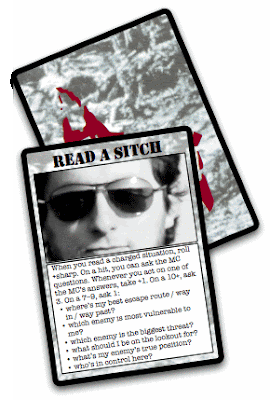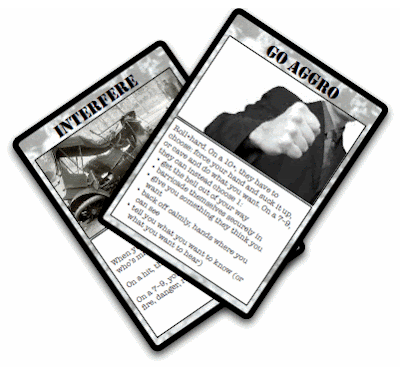 I had put off my post-gencon purchases for a while, and that combined with some curiosities of timing to result in a bundle of truly fantastic looking games to cross my threshold at roughly the same time: Dark Sun, the new DC Adventures, Blowback, Remember Tomorrow and Apocalypse World. I’m still working through the pile, but the gravitational pull of AW was too strong for me to resist, so I’ve pretty much devoured it.
I had put off my post-gencon purchases for a while, and that combined with some curiosities of timing to result in a bundle of truly fantastic looking games to cross my threshold at roughly the same time: Dark Sun, the new DC Adventures, Blowback, Remember Tomorrow and Apocalypse World. I’m still working through the pile, but the gravitational pull of AW was too strong for me to resist, so I’ve pretty much devoured it.
This isn’t a review of Apocalypse World. I might make one at some point, but others are doing a fair job of talking it up. But in the interest of summation, I would say that it was absolutely worth it’s (Slightly High) price tag. This is a complete Vincent Baker design (as opposed to some or most of a design) and while it’s worth it as a game, the reality is that the biggest interest is going to come from rules wonks and design theorists looking to see the shiny newness. I don’t think you’ll be disappointed. This is not to say my enthusiasm is unreserved, but my turnoffs are few enough and idiosyncratic enough to have no place in a nutshell.[1]
Rather, I want to zero in on a particular element of the rules that really struck me as interesting, that is to say, how strongly the rules seem in keeping with those of a Collectible (or non-Collectible) card game.
Ok, so for all the interesting things to say about AW the one that explains the most things is that there is a rule for everything. This is not necessarily to say there are a lot of rules (there aren’t) but rather that every action taken is represented with a rule. There’s no soft, interpretive space – if you’re doing something, there’s a rule for it.
These rules are called “moves”, and there’s an explicit set of them handling basic actions (Threatening people, helping, perception checks and so on) as well as class specific ones (like healing). If you want to add a new rule to the game (or make a ruling to handle a special situation) then you add a new move to represent it. This idea that everything is rules is a pretty powerful one[2] and may merit its own post at some point, but I want to zero in on a specific bit of structure to it.
The quiet workhorse of the game is a specific move called “Act Under Fire”. You use this move when you try to do something hard, and the rules are basically this: Roll 2d6 and add your cool. 2-6, you blow it and the GM does something bad. On a 10+ you pull it of. On a 7-9 you don’t quite pull it of and the GM can do things like present you with a hard choice or a diminished outcome. There’s some game-specific terminology at work, but that’s the heart of it.
It’s presented like every other move, but the trick of this particular move is that it’s the true baseline of play. Everything else is some manner of variation on this idea of success, failure and modified success. That is to say, this is the baseline rule, and every other move is basically an exception to it.
Some of you might see where this is going: Apocalypse World is a fantastic (and somewhat unique) example of exception based design. This is an idea in game design that a game will have only a very simple core set of rules, with all of the intricacies and complexities coming from rules for explicit situations (that is to say, exceptions to the normal flow of things).
This comes up a lot in the context of CCGs because most CCGs are exception based designs. The basic rules tend to be very simple: rules for drawing and playing cards, maybe some basic actions, but its all very straightforward. However, each card has a little bit of rules text on it which applies when it’s played. That’s how it gets interesting to play.[3]
Apocalypse World’s play could pretty easily be boiled down into a deck of cards, probably with less material effort than goes into most boardgames. Cards for the key elements of the character sheets and to track a few things, then cards for the moves you have personally available. And that’s pretty fascinating. The RPG that successfully incorporates CCG elements has been something of a holy grail for a while, often discussed but rarely achieved in anything but a peripheral fashion. AW’s structure suggests a clear way to do so. Not only could you easily play with the rules as is, if you want to add a random element for a different type of game entirely, the move structure would make that very easy indeed.
In any case, AW gives a lot to talk about, but this particular bit absolutely has me turning over potentials in my head.
1 – Ok, except the 6 sessions thing. That’s weak sauce.
2 – It’s also the engine behind 4e.
3 – Elizabeth S. very reasonably compares the moves to menu selection in a CRPG rather than a CCG, and rightly so, but the principal is the same, just adding menu items rather than cards.
Rob, I really like a lot of what you’re saying here about exception-based play, but I don’t quite get what you mean when you say “everything is a move.” Very explicitly, everything is not a move in AW. You do a lot of things that matter a lot and are not moves. You follow the fiction, wherever it goes, and press hard until you get to a move, where you roll. You only make up custom moves for rare-but-reoccuring circumstances that you want special moves for. Like, the “say yes or roll” for AW is: “to do it, do it” which doesn’t necessarily imply making moves at all.
Am I just reading you really wrong?
Yes an no. It might be more precise to say “Everything mechanically represented is a move”, which is another way of saying that if mechanics are engaged, they’re done so in an explicit, repeatable fashion.
Now, this is not to say I think making moves is any more frequent than rolling the dice in some other game – clearly that’s not the case – but it’s not like they’ll come up less either (at least that seems to be the case from reading – I fully concede playing may reveal something else). But what’s noteworthy is that their scope is definitely on the broad side. A lot of fiction can come out of one move. And the text, at the very least, seems to feel strongly that you should be driving towards them (though, again, I’ll cheerfully concede that may just be my read, but it seems very much where the emphasis lies).
So, in short, it feels like moves are really the engine of play, and are structured that way based on how effectively they snowball. I don’t see that as a bad thing – it sounds very much like play driving play, and that’s cool. But is that not the case? Are moves more peripheral to play than they seem?
Rob D.
PS – I’m a little leery to set aside custom moves as such an edge case. They may not be hugely necessary in vanilla AW, but they’re something people have really glommed onto, especially for building setting variants, so they’re clearly a big deal.
Curious as to where the card illustrations come from.
@rev Just threw them together with omnigraffle and some stock photos I had on hand.
There is a card-based RPG out on the market currently: Untold. I happen to have some ties to it, so this isn’t a completely neutral comment. More on the game can be found here:
http://www.untoldthegame.com/
@Robert Oh ho! I’ll have to check it out.
In terms of “everything is moves”, this is my experience:
Lots and lots of important stuff happens in play that is not moves. (Or not PC moves. Whether or not its incorporated with GM not-dice-rolling-but-still-called-moves moves is iffier.)
Moves are what happens when, inevitably, that important stuff comes up against a GM’s front and something has to give.
Dice are rolled, shit gets out of control, people die screaming, and eventually something gets resolved.
Then lots of important shit happens, much of which is not moves.
Moves are flash points, decision points, the moments when shit is going to violently change. But they aren’t everything you do. They’re just what you roll dice for.
Also, 6 sessions is bullshit. It takes many more than that. One shots are for those with no souls.
Yeah, I’d go so far as to say that most of the important stuff that happens in the game is not a move. Things like loyalty and betrayal, player decisions that are the core of the game, are left entirely outside of the mechanics.